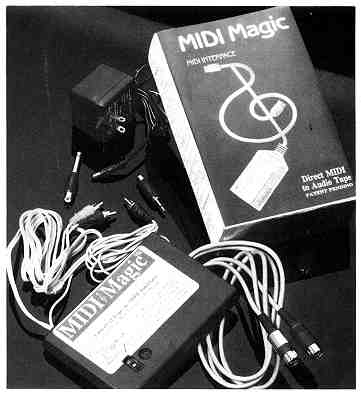MIDI Magic Tape Interface
Who Needs Reel-To-Reel?
BY MARTIN A. MAJANO
For 10 years, I played in a musical group in the San Francisco area and over the years, we recorded five 45's. Before going into the recording studio, we used to tape the rehearsals on a Teac multi-track reel-to-reel. Now, with MIDI Magic, I don't need a multi-track recorder.
MIDI Magic lets you hook up any tape recorder (cassette, reel-to-reel or micro) and any MIDI device, (keyboard, drum machine, tone generator, computer, etc.) and store your MIDI data on tape. it works with both expensive and inexpensive tape decks and recorders. In fact, I tested it with an old Sanyo tape deck, my Sons' portable recorder and a Walkman that I used to play back the MIDI recordings. it really works.
MIDI Magic is a black box about six inches by four inches and weighing about two pounds. It comes with a power supply and all the necessary cables (MIDI In, MIDI Out, Mic In, Aux In, and Ear Out) already attached. Only two of the cables are labeled, however. On top of the box is a reset button to turn the interface on and off, an LED and a switch that lets you toggle between PLAY and RECORD modes. If an error occurs, the LED light goes off. The instructions for MIDI Magic are only five paragraphs long, but that's all you'll need.

MIDI Magic by Micro-W Distributing is a unique tape
interface that lets you use any tape recorder to store
MIDI data. Connect it to a synthesizer and an inexpensive
monophonic cassette recorder and you have a complete
MIDI recording and playback system for next to nothing!
Replacing the Multi-Track Recorder
When the group broke up, I decided to buy a drum machine to keep time
and rhythm for me while I played my keyboards. I had three at that time,
but they weren't MIDI-compatible. That meant that I had to do most of the
work when I was playing. Now, thanks to MIDI Magic and a Yamaha PSR70 keyboard,
I can store my whole repertoire on a cassette.
One way to do this is to play a song and record it on the keyboard's Sequencer. When ready, I can plug in MIDI Magic and transfer the song to cassette. Or I can plug my keyboard into the ST's MIDI ports, boot Legend Software's The Final Cut sequencer program, record and edit my repertoire, then store it on disk. Then, when I plug MIDI Magic into the computer, I can dump my entire repertoire from disk through the sequencer to cassette. It's amazing.
Other Uses
The instructions say that MIDI Magic can turn your MIDI instrument
into a player piano. The company is currently converting the QRS Piano
Roll Library- over 10,000 songs from 1900 to today- to data tapes that
will play on your MIDI instrument. You can also send away for a demo tape;
see the end of this article for details.
Theoretically, you could also write a program to store data from floppy disks on tape with MIDI Magic-anyone remember the Atari 410 program recorder? I haven't tested it, but MIDI Magic could be used as a tape data backup.
MIDI Magic could also work as a means to exchange MIDI songs between different brands of computers. There's no reason that it wouldn't work- the data is stored on the tape as audio tones, so the brand of computer shouldn't matter.
Does MIDI Magic Work? You bet! Now, when I play at parties, I just take along my keyboard, MIDI Magic, a Walkman and my guitar I can then sing along to a perfect accompaniment. Play it again, MIDI Magic!
Martin Majano is a long-time musician and Atari enthusiast. This is his first article for START
PRODUCTS MENTIONED
MIDI Magic Tape Interface, $149.95; Demo Tape, $10. Micro-W
Distributing Inc., 1 342B Route 23, Butler, NJ 07405, (201) 838-9027.
CIRCLE 190 ON READER SERVICE CARD
The Final Cut, $89.95, Legend Software, 10010 107A Avenue, Edmonton,
Alberta, Canada T5H 4H8, (403) 493-8128.
CIRCLE 191 ON READER SERVICE CARD